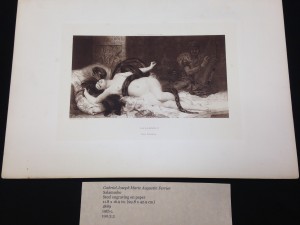The text that I chose to submit for the archival project was a poem written by Samuel Butler in 1895 entitled “In Memoriam H.R.F.”, an emotional piece that discusses Butler’s feelings after the departure of his close friend and possible lover, a Swiss student named Hans Rudolf Faesch.
The poem opens by describing the condition of Hans as he departs “into the night”: Hans is sick since he has “a racking cough” and weak lungs. Butler wishes for Heaven to guide and guard him well. Butler then discusses about “three lights” and how now there are only two remaining; this is a reference to himself, Hans, and Henry Festing Jones, another close friend whom Butler lived with. Since Hans, one of the three lights, is leaving Butler and Jones, there are now only two lights left, which saddens the two friends left behind but they have confidence in Hans since his light was “clearer and stronger than ours.”
The poem continues to praise Hans in the following stanza. There is a line that states that Hans enjoyed his time with Butler and Jones: “We gave you the best we had, such as it was, It pleased you well, for you smiled and nodded your head.” This line interested me since I saw it as a subtle innuendo to a passionate emotional and possibly homoerotic relationship that existed between the three men. Either way, the stanza implies that Hans was in good company during his stay in England.
The next stanza recounts how when the three companions began crying on the eve of Hans’ departure, Hans called themselves “a little weak.” Butler then asks what is wrong with men displaying their emotions so openly. He continues on by stating, “Therefore let tears flow on, for so long as we live No such second sorrow shall ever draw nigh us, Till one of us two leaves the other alone And goes out, out, out into the night…” This was another line that intrigued me because I interpreted this as not only a sad farewell but also as a emotional lamentation over the fact that Hans cannot remain with Butler as a possible lover. Butler adds on to this sorrow by broadening the audience to other people with similar hidden homoerotic desires: “Yet for the great bitterness of this grief…May pass into the hearts of like true comrades hereafter, In whom we may weep anew and comfort them, As they too pass out, out into the night…”
In the last stanza, Butler’s feelings over Hans’ departure are now even more prominent when he states, “…he whom we loved is gone, The like of whom we never again shall see. The wind is heavy with snow and the sea is rough.” Such lines are quite passionate since they display how special Hans was to Butler and Jones and how distraught they are over his farewell.
After reading the poem and the notes Henry Festing Jones published in the book, “Samuel Butler, Author of Erewhon (1835-1902): A Memoir, Volume 2”, I am convinced that this text is appropriate for the Victorian Queer Archive. This is because I believe that Samuel Butler’s closeted homosexual desires are evident once one studies certain stanzas of the poem as well as the notes added by Jones. Jones calls it a “Calamus poem” in reference to Walt Whitman’s own homoerotic poetry. It should also be noted that Butler had the poem removed from the public due to the ongoing Oscar Wilde trials; Butler feared that the trails, with its heightened awareness of homoeroticism in the literary world, would expose his closeted sexuality (http://www.gaynz.net.nz/history/Butler.html).
Link to my Victorian Queer Archive post: http://vqa.dickinson.edu/poem/memoriam-hrf

